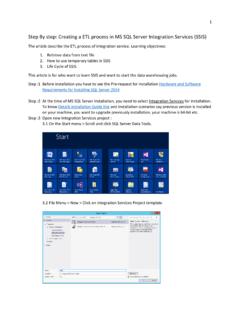Transcription of PSQL 8.3 Cheatsheet - Postgres OnLine
1 POSTGRESQL PSQL cheat sheet psql is located in the bin folder of the PostgreSQL install and PgAdmin III is psql , the PostgreSQL interactive : psql [OPTIONS].. [DBNAME [USERNAME]]General options: -c COMMAND -d, --dbname=NAME -f, --file=FILENAME --help -l, --list -v NAME=VALUE --version -X run only single command (SQL or internal) and exit specify database name to connect to (default: "logged in username here") execute commands from file, then exit show this help, then exit list available databases, then exit set psql variable NAME to VALUE output version information, then exit do not read startup file (~/.)
2 Psqlrc)Interactive Console:TYPE: \copyright \h for help with SQL commands \? for help with psql commands \g or terminate with semicolon to execute query \q to quitGENERAL: \c[onnect] [DBNAME|- USER|- HOST|- PORT|-] \cd [DIR] \encoding [ENCODING] \h [NAME] \set [NAME [VALUE]] \timing \unset NAME \prompt [TEXT] NAME \! [COMMAND] QUERY BUFFER: \e [FILE] \g [FILE] \p \r \w FILE INPUT/OUTPUT: \echo [STRING] \i FILE \o [FILE] \qecho [STRING] INFORMATIONAL: \d [NAME] \d{t|i|s|v|S} [PATTERN] (add "+" for more detail) \da [PATTERN] \db [PATTERN] \dc [PATTERN] \dC \dd [PATTERN] \dD [PATTERN] \df [PATTERN] \dF [PATTERN] \dFd [PATTERN] \dFt [PATTERN] \dFp [PATTERN] \dg [PATTERN] \dn [PATTERN] \do [NAME] \dl \dp [PATTERN] \dT [PATTERN] \du [PATTERN] \l \z [PATTERN] FORMATTING \a \C [STRING] \f [STRING] \H \pset NAME [VALUE] \t \T [STRING] \x COPY, LARGE OBJECT \copy.
3 \lo_export LOBOID FILE \lo_import FILE [COMMENT] \lo_list \lo_unlink LOBOIDfor distribution termsfor help with SQL commandsfor help with psql commandsor terminate with semicolon to execute queryto quitconnect to new databasechange the current working directoryshow or set client encodinghelp on syntax of SQL commands, * for all commandsset internal variable, or list all if no parameterstoggle timing of commands (currently off)unset (delete) internal variableprompt user to set internal variableexecute command in shell or start interactive shelledit the query buffer (or file) with external editorsend query buffer to server (and results to file or |pipe)show the contents of the query bufferreset (clear) the query bufferwrite query buffer to filewrite string to standard outputexecute commands from filesend all query results to file or |pipewrite string to query output stream (see \o)
4 Describe table, index, sequence, or viewlist tables/indexes/sequences/views/system tableslist aggregate functionslist tablespaces (add "+" for more detail)list conversionslist castsshow comment for objectlist domainslist functions (add "+" for more detail)list text search configurations (add "+" for more detail)list text search dictionaries (add "+" for more detail)list text search templateslist text search parsers (add "+" for more detail)list groupslist schemas (add "+" for more detail)list operatorslist large objects, same as \lo_listlist table, view, and sequence access privilegeslist data types (add "+" for more detail)list userslist all databases (add "+" for more detail)list table, view, and sequence access privileges (same as \dp)toggle between unaligned and aligned output modeset table title, or unset if noneshow or set field separator for unaligned query outputtoggle HTML output mode (currently off)set table output option (NAME.)
5 = {format|border|expanded|fieldsep|footer| null|numericlocale|recordsep |tuples_only|title|tableattr|pager})show only rows (currently off)set HTML <table> tag attributes, or unset if nonetoggle expanded output (currently off)perform SQL COPY with data stream to the client hostLOBOID FILEFILE [COMMENT]large object operationsConnection options: -h, --host=HOSTNAME database server host or socket directory -p, --port=PORT database server port number -U, --username=NAME connect as specified database user -W, --password force password prompt (should happen automatically)
6 -e, --exit-on-error exit on error, default is to continue -d DBNAME some databasepsql automated shell examplesrestore w hole serverpsql --host=localhost --username=someuser -f /path/ an sql batch script against a databasepsql -h localhost -U someuser -d somedb -f /path/ an sql batch script against a database and send output to filepsql -h localhost -U someuser -d somedb -f /path/ -o /path/ a single statement against a dbpsql -U Postgres -d pagila -c "CREATE TABLE test(some_id serial PRIMARY KEY, some_text text);"Output data in html formatpsql -h someserver -p 5432 -U someuser -d somedb -H -c "SELECT * FROM sometable" -o Interactive modeLaunch Interactive sessionpsql -h localhost -U Postgres -d somedbView help for SELECT * LIMIT\h SELECT * LIMITList all tables in db w ith descriptions\dt+List all tables in db w ith s in the name\dt *s*Cancel out of MORE screen.





